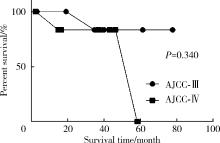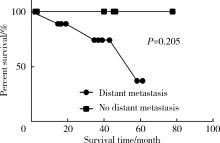Journal of Peking University (Health Sciences) ›› 2023, Vol. 55 ›› Issue (5): 802-811. doi: 10.19723/j.issn.1671-167X.2023.05.005
Previous Articles Next Articles
Clinicopathologic features and prognosis of young renal tumors with tumor thrombus
Zi-xuan XUE1,Shi-ying TANG1,Min QIU1,*( ),Cheng LIU2,*(
),Cheng LIU2,*( ),Xiao-jun TIAN1,Min LU3,Jing-han DONG1,Lu-lin MA1,Shu-dong ZHANG1
),Xiao-jun TIAN1,Min LU3,Jing-han DONG1,Lu-lin MA1,Shu-dong ZHANG1
- 1. Department of Urology, Peking University Third Hospital, Beijing 100191, China
2. Department of Urology, Shanghai First People' s Hospital, Shanghai 200940, China
3. Department of Pathology, Peking University Third Hospital, Beijing 100191, China
CLC Number:
- R737.11
| 1 |
BukavinaL , BensalahK , BrayF ,et al.Epidemiology of renal cell carcinoma: 2022 update[J].Eur Urol,2022,82(5):529-542.
doi: 10.1016/j.eururo.2022.08.019 |
| 2 | 南宁.青年肾肿瘤的临床特点及预后分析[J].中外医疗,2016,35(10):87-89. |
| 3 | 刘俊杰, 刘子颉, 夏斌,等.肾肿瘤伴静脉瘤栓患者的手术疗效及相关预后因素分析[J].徐州医科大学学报,2021,41(6):399-402. |
| 4 | 王海, 张瑞强, 王清海,等.青年肾细胞癌临床病理特点及预后分析[J].北京医学,2013,35(10):844-846. |
| 5 | 龙嘉辉. 机器人辅助腹腔镜手术治疗肾肿瘤伴静脉瘤栓的临床研究[D]. 南昌: 南昌大学, 2022. |
| 6 |
JuradoA , RomeoA , GueglioG ,et al.Current trends in management of renal cell carcinoma with venous thrombus extension[J].Curr Urol Rep,2021,22(4):23.
doi: 10.1007/s11934-021-01036-y |
| 7 | 徐之鹏, 李青楠, 董喆,等.青年肾肿瘤的临床特点分析[J].中国医科大学学报,2013,42(9):852-854. |
| 8 |
PatardJJ .Incidental renal tumours[J].Curr Opin Urol,2009,19(5):454-458.
doi: 10.1097/MOU.0b013e32832f0ccd |
| 9 | 黄力, 陈从波, 姚启盛,等.肾错构瘤并肾静脉瘤栓1例[J].现代泌尿生殖肿瘤杂志,2020,12(6):365. |
| 10 | 杨斌, 邱敏, 卢剑,等.同期后腹腔镜肾盂离断成形术联合肾部分切除术的安全性观察[J].临床泌尿外科杂志,2017,32(8):639-641. |
| 11 | 邱敏, 田晓军, 卢剑,等.后腹腔镜肾部分切除术治疗巨大(≥8 cm)肾错构瘤的技巧探讨[J].中国微创外科杂志,2017,17(10):905-908. |
| 12 | 刘茁, 朱国栋, 唐世英,等.外科手术治疗年龄≥75岁的高龄肾细胞癌合并静脉癌栓患者的临床经验[J].北京大学学报(医学版),2022,54(4):774-778. |
| 13 | 黄子雄, 杜依青, 张晓鹏,等.肾细胞癌骨转移的临床与病理分析[J].北京大学学报(医学版),2018,50(5):811-815. |
| 14 | 王林辉. 青年肾细胞癌患者的临床病理特点及诊治分析[M]// 仲剑平. 中国外科年鉴. 上海: 第二军医大学出版社, 2012: 466. |
| 15 |
CapitanioU , BensalahK , BexA ,et al.Epidemiology of renal cell carcinoma[J].Eur Urol,2019,75(1):74-84.
doi: 10.1016/j.eururo.2018.08.036 |
| 16 | 储婧.儿童肾母细胞瘤临床病理资料与预后的影响因素分析[J].临床泌尿外科杂志,2023,38(4):260-264. |
| 17 | 洪博, 董瑞.肾母细胞瘤治疗研究进展[J].临床小儿外科杂志,2021,20(6):569-575. |
| 18 | 张崔建, 李学松, 虞巍,等.成人肾母细胞瘤的治疗及其长期随访结果[J].北京大学学报(医学版),2012,44(4):535-538. |
| 19 | 王亚楠, 田亚明, 许艳平,等.儿童肾母细胞瘤的临床病理特征及预后影响因素分析[J].实用癌症杂志,2022,37(4):653-655. |
| 20 | 盛琦, 张勤, 袁晓军, 等. 儿童晚期肾母细胞瘤的诊治[C]// 浙江省医学会. 2012年江浙沪儿科学术年会暨浙江省医学会儿科学分会学术年会暨儿内科疾病诊治新进展国家级学习班论文汇编. 浙江: [出版者不详], 2012: 153-154. |
| 21 | 博尔术, 洪鹏, 张宇,等.乳头状肾细胞癌的临床病理特征和预后分析[J].北京大学学报(医学版),2022,54(4):615-620. |
| 22 | 梁宗健. 单中心非透明细胞肾癌的临床病理特征和预后分析[D]. 重庆: 重庆医科大学, 2021. |
| 23 | 邓超, 宁刚.原发肾脏尤文肉瘤2例并文献复习[J].中国CT和MRI杂志,2022,20(6):180-182. |
| 24 | 毕海, 黄毅, 马潞林,等.3例肾尤文肉瘤合并下腔静脉癌栓的诊治[J].北京大学学报(医学版),2020,52(5):985-989. |
| 25 | 方三高.延胡索酸水合酶缺陷型肾细胞癌: 一种具有同类相食、淋巴细胞吞入和自噬缺陷等多种形态的肿瘤[J].诊断病理学杂志,2023,30(2):209. |
| 26 | XuY , KongW , CaoM ,et al.Genomic profiling and response to immune checkpoint inhibition plus tyrosine kinase inhibition in FH-deficient renal cell carcinoma[J].Eur Urol,2023,83(2):163-172. |
| 27 | 徐晓晨, 甘卫东, 李笑弓,等.Xp11.2易位/TFE3基因融合相关性肾癌与肾透明细胞癌的螺旋CT诊断鉴别[J].现代泌尿外科杂志,2012,17(2):122-124. |
| 28 | PintoK , ChettyR .Gene of the month: TFE3[J].J Clin Pathol,2020,73(11):691-694. |
| 29 | 刘德乾. Vimentin和Ki-67在肾癌中的表达及其临床意义[D]. 山东: 济宁医学院, 2018. |
| 30 | 谢星, 谭建明, 吴卫真.Ki-67和p53与肾癌的相关性研究[J].临床军医杂志,2011,39(3):445-446. |
| 31 | 戴津东, 张兴明, 曾浩.转移性肾癌减瘤性肾切除术的临床决策要点及挑战[J].临床外科杂志,2021,29(2):112-116. |
| 32 | 董毅, 王林辉.转移性肾癌减瘤性肾切除术的指征该如何把握[J].中华腔镜泌尿外科杂志(电子版),2019,13(5):289-292. |
| 33 | Patel HD, Karam JA, Allaf ME. Surgical management of advanced kidney cancer: The role of cytoreductive nephrectomy and lymphadenectomy [J]. J Clin Oncol, 2018, JCO2018790246. |
| 34 | 郭圣越, 王艳.抗血管生成联合免疫检查点抑制剂治疗晚期肾癌的理论基础及研究进展[J].现代肿瘤医学,2023,31(5):979-984. |
| 35 | 李浩, 张鹤骞, 高佳宁,等.立体定向体部放疗联合靶向药物治疗转移性肾癌的研究进展[J].实用肿瘤学杂志,2022,36(6):580-584. |
| [1] | Junyong OU,Kunming NI,Lulin MA,Guoliang WANG,Ye YAN,Bin YANG,Gengwu LI,Haodong SONG,Min LU,Jianfei YE,Shudong ZHANG. Prognostic factors of patients with muscle invasive bladder cancer with intermediate-to-high risk prostate cancer [J]. Journal of Peking University (Health Sciences), 2024, 56(4): 582-588. |
| [2] | Kewei CHEN,Zhuo LIU,Shaohui DENG,Fan ZHANG,Jianfei YE,Guoliang WANG,Shudong ZHANG. Clinical diagnosis and treatment of renal angiomyolipoma with inferior vena cava tumor thrombus [J]. Journal of Peking University (Health Sciences), 2024, 56(4): 617-623. |
| [3] | Shuai LIU,Lei LIU,Zhuo LIU,Fan ZHANG,Lulin MA,Xiaojun TIAN,Xiaofei HOU,Guoliang WANG,Lei ZHAO,Shudong ZHANG. Clinical treatment and prognosis of adrenocortical carcinoma with venous tumor thrombus [J]. Journal of Peking University (Health Sciences), 2024, 56(4): 624-630. |
| [4] | Jie YANG,Jieli FENG,Shudong ZHANG,Lulin MA,Qing ZHENG. Clinical effects of transesophageal echocardiography in different surgical methods for nephrectomy combined with Mayo Ⅲ-Ⅳ vena tumor thrombectomy [J]. Journal of Peking University (Health Sciences), 2024, 56(4): 631-635. |
| [5] | Binshuai WANG,Min QIU,Qianjin ZHANG,Maofeng TIAN,Lei LIU,Guoliang WANG,Min LU,Xiaojun TIAN,Shudong ZHANG. Experience in diagnosis and treatment of 6 cases of renal Ewing's sarcoma with venous thrombus [J]. Journal of Peking University (Health Sciences), 2024, 56(4): 636-639. |
| [6] | Le YU,Shaohui DENG,Fan ZHANG,Ye YAN,Jianfei YE,Shudong ZHANG. Clinicopathological characteristics and prognosis of multilocular cystic renal neoplasm of low malignant potential [J]. Journal of Peking University (Health Sciences), 2024, 56(4): 661-666. |
| [7] | Zezhen ZHOU,Shaohui DENG,Ye YAN,Fan ZHANG,Yichang HAO,Liyuan GE,Hongxian ZHANG,Guoliang WANG,Shudong ZHANG. Predicting the 3-year tumor-specific survival in patients with T3a non-metastatic renal cell carcinoma [J]. Journal of Peking University (Health Sciences), 2024, 56(4): 673-679. |
| [8] | Yangyi FANG,Qiang LI,Zhigao HUANG,Min LU,Kai HONG,Shudong ZHANG. Well-differentiated papillary mesothelial tumour of the tunica vaginalis: A case report [J]. Journal of Peking University (Health Sciences), 2024, 56(4): 741-744. |
| [9] | Yuanyuan ZENG,Yun XIE,Daonan CHEN,Ruilan WANG. Related factors of euthyroid sick syndrome in patients with sepsis [J]. Journal of Peking University (Health Sciences), 2024, 56(3): 526-532. |
| [10] | Yifan WU,Yingxiang YU,Lan XIE,Zhida ZHANG,Cuiqing CHANG. Characteristics of resting energy expenditure and evaluation of prediction formulas in young men with different body mass indexes [J]. Journal of Peking University (Health Sciences), 2024, 56(2): 247-252. |
| [11] | Jian-bin LI,Meng-na LYU,Qiang CHI,Yi-lin PENG,Peng-cheng LIU,Rui WU. Early prediction of severe COVID-19 in patients with Sjögren’s syndrome [J]. Journal of Peking University (Health Sciences), 2023, 55(6): 1007-1012. |
| [12] | Huan-rui LIU,Xiang PENG,Sen-lin LI,Xin GOU. Risk modeling based on HER-2 related genes for bladder cancer survival prognosis assessment [J]. Journal of Peking University (Health Sciences), 2023, 55(5): 793-801. |
| [13] | Dong LAN,Zhuo LIU,Yu-xuan LI,Guo-liang WANG,Xiao-jun TIAN,Lu-lin MA,Shu-dong ZHANG,Hong-xian ZHANG. Risk factors for massive hemorrhage after radical nephrectomy and removal of venous tumor thrombus [J]. Journal of Peking University (Health Sciences), 2023, 55(5): 825-832. |
| [14] | Min QIU,You-long ZONG,Bin-shuai WANG,Bin YANG,Chu-xiao XU,Zheng-hui SUN,Min LU,Lei ZHAO,Jian LU,Cheng LIU,Xiao-jun TIAN,Lu-lin MA. Treatment outcome of laparoscopic partial nephrectomy in patients with renal tumors of moderate to high complexity [J]. Journal of Peking University (Health Sciences), 2023, 55(5): 833-837. |
| [15] | Han LU,Jian-yun ZHANG,Rong YANG,Le XU,Qing-xiang LI,Yu-xing GUO,Chuan-bin GUO. Clinical factors affecting the prognosis of lower gingival squamous cell carcinoma [J]. Journal of Peking University (Health Sciences), 2023, 55(4): 702-707. |
|
||





